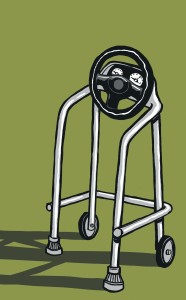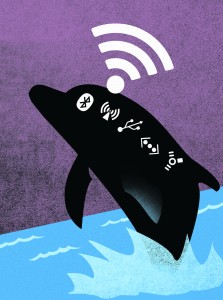SATURDAY, 7 MAY 2011
No headache for woodpeckersSevere decelerations of nearly 12,000 ms-2 as it scours a tree for its meal. Hammering away with rates of 22 beats per second would leave the best of us with more than a concussion, yet the woodpecker can do this without suffering any brain damage. Scientists are now looking into ways of harnessing the woodpecker’s special abilities to build better shock-absorbers. Using computer tomography scans and video footage of these birds in action they found that the birds possess properties that help absorb mechanical shocks efficiently: a layer of fluid between the brain and skull to attenuate vibrations, a hard but slightly elastic beak, a springy structure called the hyoid that extends behind the skull, and a section of soft skull bone. By using materials, such as rubber and aluminium, as artificial analogues of these four absorbers, a ‘woodpecker-inspired shock absorbing system’ that was able to offer effective protection against bullet blows up to 600,000 ms-2 was created. The implicated uses of this new technology are in aeroplanes’ black boxes (flight recorders currently in use can withstand shocks of about 10,000 ms-2), cars and as protection for satellites against space debris. So before banging your head against a brick wall next time, consider imitating a woodpecker! Georgie Ward
Life in the slow lane
Ever been a passenger in a car, and wished the driver would slow down a little? Russ Branaghan of Arizona State University might have a neat solution. In a study on young drivers of both sexes, it was found that the surreptitious suggestion of words and sentences to do with being elderly resulted in a lower maximum speed and longer driving times. The words were introduced to the driver as scrambled sentence problems, posed via heads-up display while the vehicle was stationary at traffic lights. Measured against a control with non age-related phrases, it seems that while participants reported no realisation of any themes, to think age is to drive aged—careful you don’t catch the bug! No blue rinse required... Mike Kenning
Seeing through the blindfold?
A team at the dolphin research centre in Grassy Key, Florida, has witnessed dolphins mimicking the movements of other dolphins without being able to see them. Tanner, a male bottlenosed dolphin, was given the signal by Dr Kelly Jaakkola to imitate its partner dolphin, Kibby. Tanner was then blindfolded with opaque goggles, but remarkably, was still able to copy turns and tricks from Kibby. The team tested 19 motor and 8 vocal behaviours. Dr Kelly said Tanner must have been able to follow Kibby “either by recognising the characteristic sound that the behaviour makes, like you or I may recognise the sound of hands clapping, or by using echolocation”. Also known as bisonar, echolocation is predominantly used by bats and dolphins to ‘view’ objects around them using the echoes of sound waves. The study, published in the International Journal of Comparative Psychology, shows that dolphins can adapt the senses they use when imitating an action, the first time this has been shown in an animal other than humans. Tom Bishop


